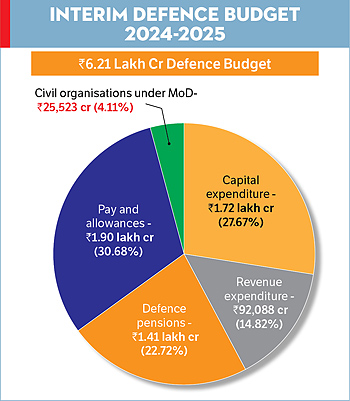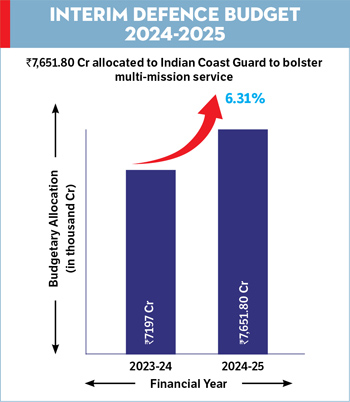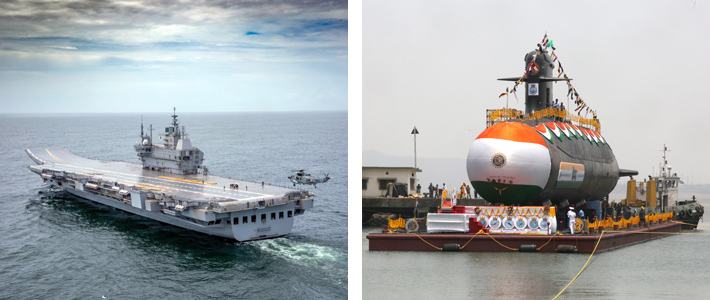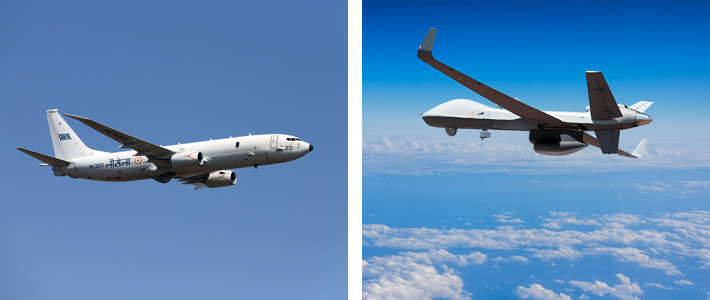INDIAN ARMED FORCES CHIEFS ON OUR RELENTLESS AND FOCUSED PUBLISHING EFFORTS

The insightful articles, inspiring narrations and analytical perspectives presented by the Editorial Team, establish an alluring connect with the reader. My compliments and best wishes to SP Guide Publications.

"Over the past 60 years, the growth of SP Guide Publications has mirrored the rising stature of Indian Navy. Its well-researched and informative magazines on Defence and Aerospace sector have served to shape an educated opinion of our military personnel, policy makers and the public alike. I wish SP's Publication team continued success, fair winds and following seas in all future endeavour!"

Since, its inception in 1964, SP Guide Publications has consistently demonstrated commitment to high-quality journalism in the aerospace and defence sectors, earning a well-deserved reputation as Asia's largest media house in this domain. I wish SP Guide Publications continued success in its pursuit of excellence.
- MoD initiates comprehensive review of Defence Acquisition Procedure 2020, pushes for defence reforms
- G7: The Swansong
- Kalinga Connect: South Asia to Polynesia
- Advanced MRSAM for India for a greater firepower
- Must Credit DRDO for Operation Sindoor, now what is next for defence R&D?
- Operation Sindoor | Day 2 DGMOs Briefing
- Operation Sindoor: Resolute yet Restrained
Interim Defence Budget 2024-25 — An Analysis
Navigating the realities of India's Defence Budget and charting the road ahead
 |
The Author was the Flag Officer Commanding-in-Chief, Southern Naval Command when he retired on November 30, 2021. He is a Navigation and Direction specialist. He was also the Director General Naval Operations and the Chief of Personnel, Indian Navy. |

India's Interim budget for Financial Year (FY) 2024-25 was tabled by the Finance Minister on February 1, 2024. Expectedly, it did not contain any significant new measures, being an Interim budget due to the impending general elections in India. However, the budget being the last such announcement by the current government, is an apt occasion to take stock, not only of the current budget, but also of trends of the defence budget during the last ten years of the current government, as it could portend what happens over the next five years as well.
Introduction

If we examine the defence budgets over the past decade (2014-24), a few macro trends are evident. These include attempts to enhance capital expenditure and reduce revenue expenditure; emphasis on indigenisation (Atmanirbharta); provision of additional Revenue funds for making good critical capability shortfalls; strengthening of border infrastructure, especially roads on our northern border; provision of funds for technology development; etc. There has been an average annual increase of about 8 per cent in the defence budget in the period 2014-24, though the increase in real terms has eroded considerably due to an average inflation of about 5 per cent (and a peak of 8 per cent) during the same period. Significantly, there has been a steady drop in the percentage of national spending on defence from about 20 per cent in 2014-15 to around 13 per cent in 2024-25, which is an indicator of the Indian economy's growing strength. The percentage of GDP spent on defence expenditure during the period has constantly been under 2 per cent, with an average annual expenditure of about 1.8 per cent of GDP.
The defence budget for FY 2024-25 totals 6,21,540.85 crore, representing 13.04 per cent of the national budget
The areas of emphasis pursued by the government over the past decade have generally delivered good results. Indigenisation and technology development has received a much-needed impetus, critical capability shortfalls have been significantly reduced and border infrastructure has been enhanced. However, the expected reduction in Revenue expenditure on pensions, pay and allowances, and the expected increase in Capital expenditure have not entirely been realised, in major part because the overall growth in India's defence budget over the past decade has been modest. This has ensured that the modernisation of the Armed Forces has remained confined to a few select areas, with several critical capability voids yet to be addressed, which are discussed later in this article.
Interim Defence Budget 2024-25
As per the Press Information Bureau (PIB) brief dated February 1, 2024, the Government of India has allocated 6,21,540.85 crore for defence in 2024-25, which comprises 13.04 per cent of the total national budget (the highest allocation amongst all ministries) and amounting to 1.89 per cent of GDP. This year's defence budget is 4.72 per cent higher than the Budget Estimates (BE) for 2023-24 but marginally lower 0.37 per cent than last year's Revised Estimates (RE). The share of Capital expenditure in the budget is 27.67 per cent; Revenue expenditure on sustenance and operational readiness comprises 14.82 per cent; Pay and Allowances comprises 30.68 per cent; Defence Pensions 22.72 per cent; and Civil Organisations under the MoD 4.11 per cent. It is evident that the defence budget is weighed heavily in favour of Revenue expenditure, with over 50 per cent of the allocation going towards pay and allowances. A new measure introduced in the budget is the consolidation of procurements by the three Services under common heads such as aircraft, aero engines, heavy and medium vehicles, etc to foster jointness and flexibility in budget management.
The budget allocates 1.72 lakh crore for Capital expenditure, aimed at acquisitions for the Indian Navy and Air Force

The Capital outlay of 1.72 lakh crore is 9.40 per cent more than RE for 2023-24 and 5.78 per cent more than BE for 2023-24 - modest increases if the year-on-year inflation is factored. Major Capital acquisitions planned for the Indian Navy (IN) include deck-based fighter aircraft, submarines, next-generation survey vessels, etc. Capital acquisitions on the radar for the Indian Air Force (IAF) include modernisation of the Su-30 fleet, additional Su-30s, engine upgrade for MiG-29s, procurement of C295, funding of the LCA MK-IOC/FOC configuration. No major capital acquisitions for the Indian Army have been mentioned in the press note, which indicates that these might be relatively smaller procurements.
Of the 2.82 lakh crore allocated for Revenue expenditure, 92,088 crores have been earmarked for sustenance and operational commitments, which includes heads such as fuel, spares, repair, transportation, victuals, etc. The budgetary allowance for defence pensions has gone up to 1.41 lakh crore, an increase of only 2.17 per cent over the previous year's allocation, which if inflation is considered, indicates negative growth under this head. A welcome step has been the unprecedented increase of 28 per cent to the Ex-Servicemen Welfare Scheme (ECHS), which will ensure the clearing of pending bills, and the decision to equate ECHS rates with CGHS rates, which will ensure better health care for over 32 lakh retired defence personnel.
A corpus of 1 lakh crore is earmarked for 'Deep Tech' initiatives in defence sector, aiming to spur innovation

The PIB note indicates that a corpus of 1 lakh crore - a huge sum by any account - has been earmarked for 'Deep Tech' to provide long term loans to tech savvy youth and companies and tax advantage to start-ups to give impetus to innovation in the defence sector. While a welcome step to encourage indigenous defence technologies, it is not clear whether this corpus would go from the defence budget. The nature of this corpus also implies that funds would be disbursed on 'as required' basis. Unless created separately, considering the pace of innovations, it is quite likely that a major part of this corpus could lapse at the end of the current financial year (CFY).
The Indian Coast Guard (ICG) has continued to get a healthy increase in budgetary support, the outlay for 2024-25 being 6.31 per cent higher than the previous year's allocation. The Capital to Revenue ratio of the ICG remains very healthy, with 3,500 crore from the total allocation of 7,651.80 crore being for Capital expenditure and the rest being allocated for Revenue expenditure.
Outlay for the Indian Navy
The IN got the smallest share of the defence budget (18.9 per cent) between the three Services as per the RE for FY 2023-24 and this trend continues for FY 2024-25. The 36th report (2023-24) by the Parliament's Standing Committee on Defence (SCOD) on the Demands for Grants for FY 2023-24, released in March 2023, had stated that in FY 2022-23, the Capital to Revenue ratio of the IN was a healthy 68:32. In FY 2023-24, the Capital allocation of the IN was the second highest, after the IAF, with 52,804.75 crore being allocated in BE 2023-24. The report also stated that Acceptance of Necessity (AoN) had been accorded to 35 schemes worth 1,20,797.31 crore. The major schemes for ships accorded AoN include the Fleet Support Ships, Cadet Training Ships, Next Generation OPVs, Next Generation Corvettes, etc. However, it is not known as to how many of the AoNs have reached the contract conclusion stage.


In FY 2024-25, while the overall Capital expenditure outlay for the three Services is 1.72 lakh crore, there is insufficient clarity on the division of this allocation between the Indian Army, IN and the IAF due to the bunching of similar Capital procurements under common heads for the first time, as mentioned above. However, an outlay of 23,800 crore has been mentioned under the Capital head for 'Naval Fleet' and 6,380 crore for 'Dockyard Projects'. The budget also recognises the multiplier effect of 1.82 in the ship-building sector, stating that 1.5 lakh crore in naval ship-building projects would accrue a monetary circulation of 2.73 lakh crore. While there is no word regarding the procurement of the second indigenous aircraft carrier (IAC-2) or approval for the indigenous SSN programme, the fact that the multiplier effect of shipbuilding in terms of domestic investment, job growth and technology development has not only been recognised, but also quantified, is a positive indicator in the eventual realisation of these key procurement programmes.
Apart from the IAC-2 and the SSN, the IN requires to obtain approval for a range of ships, submarines, aircraft and weapons. Some of the platforms required, as available from the public domain, include the P-75(I) submarines, additional frigates/ destroyers, minesweeping / mine-hunting platforms, additional long range and medium range maritime patrol aircraft, Remotely Piloted Aircraft (RPA), etc, which are at advanced stage of approval through the defence procurement process. If approved during the current FY, these schemes would require additional funding, which currently may not be available. However, additional funds could be allocated during the Annual budget by the next government in July this year (after the general elections).
32,778 crore has been earmarked under the non-salary Revenue budget for the IN, with the Indian Army and IAF being allocated 1,92,680 crore and 46,223 crore respectively. This would appear to be sufficient for meeting the IN's requirements. As such, additional funds have historically been made available when required for operational commitments.
Conclusion
In the oral evidence provided by the naval representative to the 36th SCOD, the maritime threat perception to India vis-à-vis China's growing maritime power was clearly brought out. The naval representative also stated that meeting this challenge required sustained funding, as shipbuilding programmes have long gestation periods of 10-15 years. This need was echoed in the SCOD report, noting that expenditure on new schemes as compared to committed liabilities had reduced, indicating that the IN's modernisation drive was slowing. The committee also unambiguously recommended expeditious approval for IAC-2.
As is evident from the figures allocated to defence expenditure during the interim budget, the increase in defence spending has been modest. In a sense, this was inevitable - not only because it is an interim budget but also due to electoral compulsions. The fact remains that overall defence expenditure needs to go up if the current imbalance between Revenue and Capital expenditure is to be redressed and modernisation of the Armed Forces is to progress in accordance with the Long-Term Integrated Procurement Plan (LTIPP). Hopefully, this would be addressed in the Annual budget of the Union, which will be presented by the new government formed after the General Elections, likely to be scheduled in the next two months.





